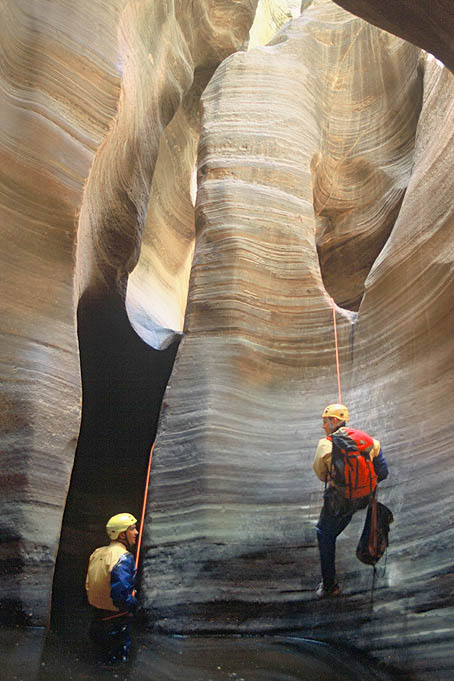More on Canyoneering Ethics
Descending technical canyons necessarily requires some impacts. Or does it? Many of these technical canyons have been descended leaving them as God made 'em. Ethics is about minimizing your impact, and leaving as little as possible behind. Take nothing but memories, leave nothing but footprints, and as few of those as possible.
Using a natural bridge to anchor a rap in Imlay.
It leaves rope-grooves in the rock...would a bolt be better?
Anything you leave behind is trash. Trash is ugly. Trash interrupts the naturalness of the environment. You, and the people coming after you, are there to revel in God's work, not to see stuff left behind by previous humans. It is good style and good ethics to leave behind as little as possible.
Since we are talking about technical canyons, it is worth discussing the trash hierarchy. Here is my list:
WORST
Getting Killed.
Getting Hurt. Leaving blood.
Requiring rescue.
Bad Anchors that are dangerous to other people.
Careless Trash: common litter, human waste, broken gear
Obvious Trash: stuck ropes, fixed ropes.
Superfluous and Unnecessary Anchors.
Bright-Colored Slings.
Climbing Hardware including drilled Anchors.
Black or Natural colored slings around natural anchors.
Footprints.
Nothing at all.
BEST
Let's start at the top, shall we? Getting yourself killed, seriously hurt or stuck-requiring-rescue has the biggest impact on the canyon. Bodies and ghosts are yucky. Pools of blood are in bad taste, though they eventually wash away. Requiring rescue is a poor use of the local sheriff's time and energy, and usually ends up impacting the environment to a high degree. Bad.
Jumping into pools is really fun until someone breaks a leg. Check pool depths carefully before jumping, as suitable pools are rare on the Colorado Plateau. Rap the first person down on a rope, and have them check the pool for depth and obstacles. Jumping into mystery pools is a good way to shorten all sorts of things.
When placing anchors of any kind, be responsible and place good ones. Other people will probably rely upon them in the future; don't leave Time Bombs.
Natural anchor?
Is this braced log in Englestead Canyon really a natural anchor?
Leaving trash behind is damn inconsiderate. I don't suppose I need to tell you to pack out your Power Bar wrappers and water bottles. You should also pack out your very own excrement. Carry a sturdy tupperwear container with a couple heavy duty ziplocs or a Restop bag OR avoid the problem entirely by getting rid of that crap before entering the canyon. If you get a rope stuck and leave it, you are obliged to get back there as soon as possible and clean it up. I don't care how much of a pain it is: do your duty.
If placing fixed ropes for safety or exploration, be courteous and don't leave them longer than necessary. In obscure canyons, a few weeks might be acceptable. In more obvious canyons, a few days is not. Do not be surprised if your ropes disappear; one person's safety line is another person's booty, and yet another's litter. Anything left behind is fair game.
Placing unnecessary anchors is the same as leaving trash. Placing 'courtesy' anchors to make a descent easier or 'safer' is highly discouraged. Before reaching for the drill, think really hard and explore the area thoroughly. Reliable sources report our canyons do not require ANY drilled anchors. The natural-anchor game is an intriguing game, and does not require compromising safety.
Do not use bright colored slings and hardware. Carry black or natural colored webbing. In Australia, the ethic is to use natural fiber ropes for anchors, so they will rot back into the environment.
And this brings us to... PLACING FIXED ANCHORS.
Before desecrating the wilderness and placing a fixed anchor, consider the following alternatives:
Don't. Come back another day. Come back when the potholes are fuller, the company more competent, or your own skills more honed.
Be Bold. Downclimb or upclimb free, rather than placing gear. Go around. Is it worth it to place an anchor just to complete this section, when it is easily bypassed?
Use the Previous Anchor. Get the most out of your anchors by rappelling as long as possible. Exercise judgement, however, as getting your rope stuck is a bad thing. When descending an established canyon, don't pull your rope until you locate the next anchor.
Be Creative. Use your eyes and your brain. Here are some creative anchors:
Natural arches, holes in the rock and/or spikes of rock, with or without a sling.
Rocks, logs or hunks of wood jammed in a slot or pothole.
Rocks, logs or hunks of wood buried in the sand.
A fair mass of bushes, that can be slung with a long sling placed just so.
That tree up and left, that you can boulder up to.
Have your buddy anchor the rope with body weight, and then not continue with you but exit the canyon otherwise. (Return the favor on another occasion).
Have your buddy anchor the rope with body weight, and then downclimb with an aggressive spot (if safe).
Learn to safely use a Sandtrap system, which will greatly expand your potential for LNT canyon descents.
Natural anchors can sometimes be found 10, 20 or 50 feet upcanyon, or jammed above you in the canyon. Use your eyes and your creativity. When building "natural" anchors, try not to make a mess. Big cairns and obviously braced logs are obvious human artifacts and take away from the naturalness of the canyons, too (see above).


